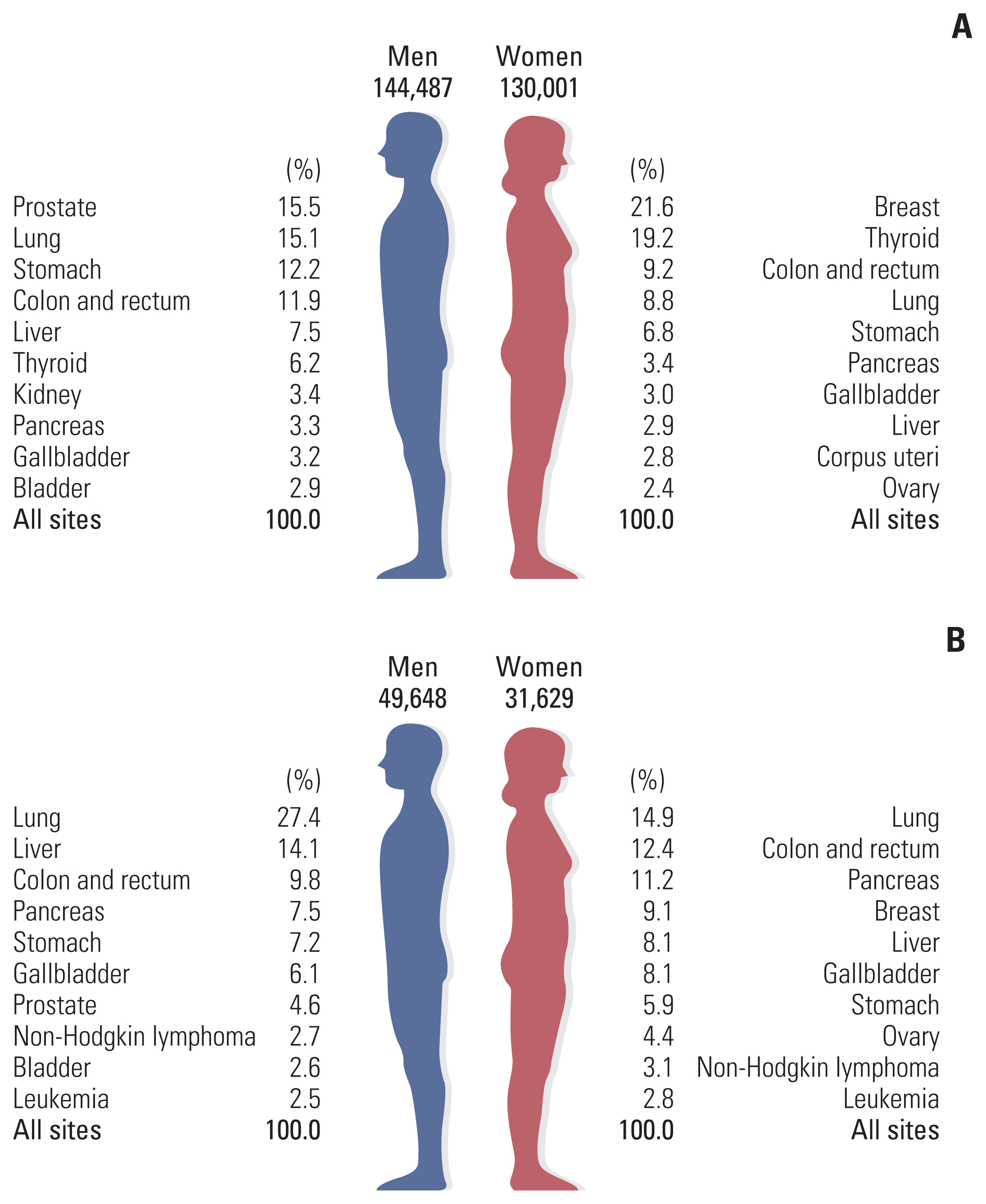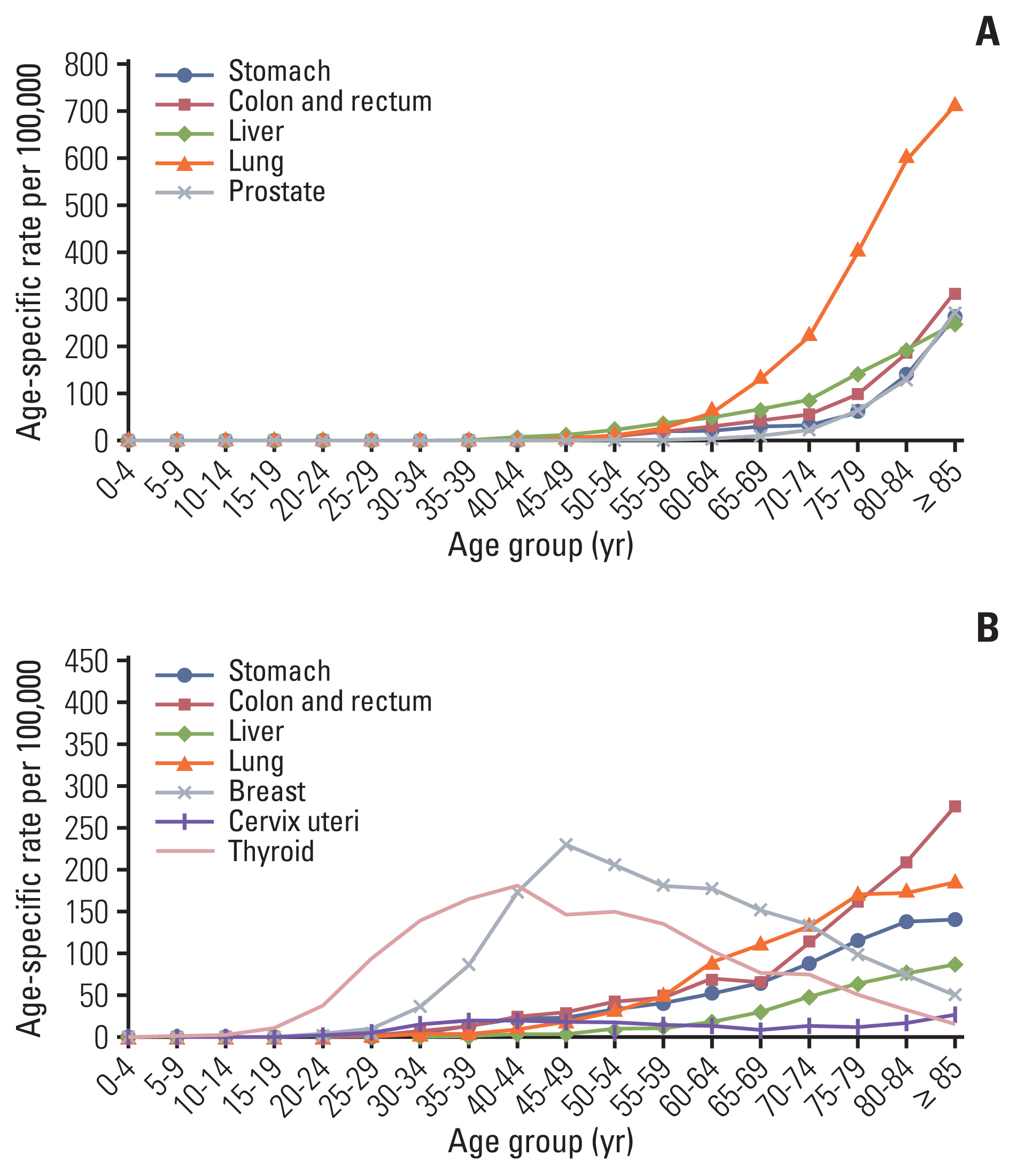AbstractPurposeThis study aimed to report the projected cancer incidence and mortality for the year 2022 to estimate Korea’s current cancer burden.
Materials and MethodsCancer incidence data from 1999 to 2019 were obtained from the Korea National Cancer Incidence Database, and cancer mortality data from 1993 to 2020 were acquired from Statistics Korea. Cancer incidence and mortality were projected by fitting a linear regression model to observed age-specific cancer rates against their respective years and then by multiplying the projected age-specific rates by the anticipated age-specific population for 2022. A joinpoint regression model was used to determine the year in which the linear trend changed significantly; we only used the data of the latest trend.
ResultsIn total, 274,488 new cancer cases and 81,277 cancer deaths are expected to occur in Korea in 2022. The most common cancer site is expected to be the thyroid, followed by the lung, colon and rectum, breast, and stomach. These five cancers are expected to represent half of the overall burden of cancer in Korea. The most common type of cancer leading to death is expected to be lung cancer, followed by liver, colorectal, pancreatic, and gallbladder cancers.
IntroductionAs the leading cause of death in Korea [1], cancer has been a major public health concern in the country since 1983. More than 240,000 patients were newly diagnosed with cancer in Korea, and one-fourth of deaths were due to cancer in 2018 [2]. Although the cancer registration system in Korea is highly efficient and can provide nationwide cancer statistics within a relatively short period, a lag time of at least 2 years is required to collect and analyze data for a specific year. For planning and implementing comprehensive cancer-control programs, it is important to assess the number of new cases and deaths that are expected to occur during the current year. In this study, we report the projected cancer incidence and mortality for the year 2022 based on data from the 1990s to 2019.
Materials and MethodsThe Korean Ministry of Health and Welfare initiated a nationwide, hospital-based cancer registry, known as the Korea Central Cancer Registry (KCCR), in 1980. The history, objectives, and activities of the KCCR have been documented in detail elsewhere [3]. Cancer incidence data from 1999 to 2019 were obtained from the Korea National Cancer Incidence Database (KNCI DB). Cancer cases were classified according to the International Classification of Diseases for Oncology, 3rd edition [4] and converted according to the International Classification of Diseases, 10th edition (ICD-10) [5]. Mortality data from 1993 to 2020 were acquired from Statistics Korea [1]. The cause of death was coded and classified according to the ICD-10 [5].
The cancer sites included in this study were (1) all cancer sites combined and (2) the 24 cancer sites as follows: lips, oral cavity, and pharynx (C00–C14), esophagus (C15), stomach (C16), colon and rectum (C18–C20), liver (C22), gallbladder etc. (C23–C24), pancreas (C25), larynx (C32), lung (C33–C34), breast (C50), cervix uteri (C53), corpus uteri (C54), ovary (C56), prostate (C61), testis (C62), kidney (C64), bladder (C67), brain and central nervous system (C70–C72), thyroid (C73), Hodgkin lymphoma (C81), non-Hodgkin lymphoma (C82–C86, C96), multiple myeloma (C90), leukemia (C91–C95), and other and ill-defined sites (remainder of C00–C96).
The population data from 1993 to 2022 were obtained from the resident registration population data, reported by Statistics Korea. Data of the mid-year population (July 1 of the respective year) were used as the denominator to obtain the annual incidence and mortality rates. However, for the year 2022, we used the population data on December 31, 2020, as the mid-2022 resident registration population data were not yet available at the time of the analysis.
Linear regression models [6] were used to assess time trends and create projections. We first performed a joinpoint regression analysis on the data available to detect the year when significant changes occurred in cancer trends according to sex and cancer site. A joinpoint regression describes changes in data trends by connecting several different line segments on a log scale at “joinpoints.” This analysis was performed using Joinpoint software (Version 4.7.0.0; http://surveillance.cancer.gov/joinpoint) from the Surveillance Research Program of the US National Cancer Institute [7]. For the analysis, we arranged to have at least four data points between consecutive joinpoints. Secondly, to predict age-specific cancer rates, a linear regression model was fitted to age-specific rates by 5-year age groups against their respective years, based on the observed cancer incidence data of the latest trends. Finally, we multiplied the projected age-specific rates by the age-specific population to get the projected number of cancer cases and deaths for the year 2022.
We summarized the results using crude rates (CRs) and age-standardized rates (ASRs) of cancer incidence and mortality. ASRs were standardized using the world standard population [8] and expressed per 100,000 persons.
Results1. IncidenceIn total, 274,488 new cancer cases are expected to occur in 2022 (Table 1, Fig. 1); more men (n=144,487) than women (n=130,001) are expected to be affected.
The projected CRs per 100,000 for all of the sites combined in 2022 are 561.2 cases and 502.1 cases for men and women, respectively (Table 2). The projected ASRs per 100,000 for all of the sites combined are 289.9 cases and 276.1 cases for men and women, respectively. In men, the five leading primary sites of cancer are expected to be the prostate (CR, 87.0; ASR, 40.3), lung (CR, 84.8; ASR, 39.4), stomach (CR, 68.3; ASR, 34.0), colon and rectum (CR, 66.8; ASR, 33.8) and liver (CR, 41.9; ASR, 20.9), accounting for 62.1% of all new cancer cases in 2022. In women, the five leading primary sites are expected to be the breast (CR, 108.3; ASR, 66.1), thyroid (CR, 96.3; ASR, 71.2), colon and rectum (CR, 46.3; ASR, 19.8), lung (CR, 44.3; ASR, 18.6), and stomach (CR, 34.1; ASR, 15.3), accounting for 65.6% of all new cancer cases in 2022 (Fig. 1).
The five most common cancer sites expected in 2022 according to sex and age group are shown in Table 3. Leukemia and thyroid cancer are expected to be the most common forms of cancer in both sexes for those aged 0–14 years and 15–34 years, respectively. Colorectal cancer is predicted to be the most prevalent cancer in men aged 35–64 years, while prostate cancer is expected to be more frequent in men aged 65 years and above. Breast cancer is predicted to be the most common cancer in women aged 35–64 years, whereas lung cancer is expected to be the most common form in women aged 65 years and above. According to the projection, the incidences of stomach, lung, liver, colorectal, and prostate cancers will increase gradually with age for men (Fig. 2A). In women, the age-specific incidence rates for stomach, colorectal, liver, lung, and cervical cancers denote an increasing trend with age; however, the incidences of breast and thyroid cancers in women are expected to level off after the age of 45 and 50 years, respectively (Fig. 2B).
2. MortalityIt is estimated that 81,277 cancer deaths will occur in Korea during 2022 (Table 1, Fig. 1). The projected CRs per 100,000 for all of the sites combined in 2022 for men and women are 192.8 cases and 122.2 cases, respectively, whereas the projected ASRs per 100,000 for all sites combined for men and women are expected to be 89.1 cases and 44.0 cases, respectively (Table 4). The predicted five leading cancer sites causing mortality in men are the lung (CR, 52.9; ASR, 23.4), liver (CR, 27.2; ASR, 13.0), colon and rectum (CR, 18.9; ASR, 8.8), pancreas (CR, 14.5; ASR, 6.8), and stomach (CR, 13.9; ASR, 6.5). During the same period, lung cancer (CR, 18.2; ASR, 5.9) is projected to be the leading cause of cancer death in women, followed by colon and rectal (CR, 15.1; ASR, 4.7), pancreatic (CR, 13.7; ASR, 4.6), breast (CR, 11.2; ASR, 5.7), and liver (CR, 9.9; ASR, 3.2) cancers.
The predicted age-specific mortality rates of the leading causes of cancer-associated death in men and women in 2022 are shown in detail in Fig. 3. According to age, Korean men and women aged at least 60 years are expected to have the highest mortality rates due to lung cancer.
ConclusionA total of 274,488 new cancer cases and 81,277 cancer deaths are expected to occur in Korea during 2022. Prostate cancer is predicted to be the most common type of cancer among men, followed by lung, stomach, colorectal, and liver cancers. Lung, liver, colorectal, pancreatic, and stomach cancers are expected to be the most common causes of cancer deaths among men. In women, the five leading primary cancer sites are expected to be the breast, thyroid, colon and rectum, lung, and stomach, while lung, colorectal, pancreatic, breast, and liver cancers are projected to be the most common causes of cancer deaths.
Cancer is currently one of the foremost public health concerns in Korea. Although cancer incidence rates are anticipated to slightly decrease, the burden of most types of cancers will continue to grow with the increasing age of the population. The current projections of cancer incidence and mortality for 2022 represent an important resource for planning and evaluating cancer-control programs. As the estimates in this study are model-based, these results should be interpreted with caution.
AcknowledgmentsThe authors would like to thank the tumor registrars (health information managers) of the KCCR-affiliated hospitals and non-KCCR-affiliated hospitals for the assistance with data collection, abstraction, and coding. Additionally, we acknowledge the cooperation of the National Health Insurance Service and Statistics Korea for their support with the data.
This work was supported by the National Cancer Center research grant (No. 2211110).
NotesFig. 1The 10 leading types of estimated new cancer cases and deaths by sex in 2022. (A) Estimated new cases. (B) Estimated deaths. 
Fig. 3Projected age-specific mortality rates of major cancers during 2022 in Korea. (A) Men. (B). Women. 
Table 1Estimated new cancer cases and deaths by sex during 2022 in Korea
Table 2Estimated crude and age-standardized cancer incidences by sex during 2022 in Korea
Table 3Estimated cancer incidence by age group and sex during 2022 in Korea
Table 4Estimated crude and age-standardized cancer mortality rates by sex during 2022 in Korea
References1. Statistics Korea [Internet]. Daejeon: Statistics Korea; 2022. [cited 2022 Mar 8]. Available from: http://kosis.kr
2. Hong S, Won YJ, Lee JJ, Jung KW, Kong HJ, Im JS, et al. Cancer statistics in Korea: incidence, mortality, survival, and prevalence in 2018. Cancer Res Treat. 2021;53:301–15.
3. Shin HR, Won YJ, Jung KW, Kong HJ, Yim SH, Lee JK, et al. Nationwide cancer incidence in Korea, 1999–2001: first result using the National Cancer Incidence Database. Cancer Res Treat. 2005;37:325–31.
4. Fritz A, Percy C, Jack A, Shanmugaratnam K, Sobin L, Parkin DM, et al. International classification of diseases for oncology. 3rd ed 1st rev. Geneva: World Health Organization; 2013.
5. World Health Organization. International statistical classification of diseases and related health problems. 10th rev. Geneva: World Health Organization; 1994.
6. Boyle P, Parkin DM. Statistical methods for registries. In : Jensen OM, Parkin DM, MacLennan R, Muir CS, Skeet RG, editorss. Cancer registration: principles and methods. IARC Scientific Publication No 95Lyon: IARC Press; 1991. p. 126–58.
7. National Cancer Institute. Joinpoint regression program, version 4.8.0.1 [Internet]. Bethesda, MD: National Cancer Institute; 2020. [cited 2022 Feb 18]. Available from: http://surveil-lance.cancer.gov/joinpoint/
8. Segi M. Cancer mortality for selected sites in 24 countries 1950–1957. Sendai: Tohoku University School of Medicine; 1960.
|
|
|||||||||||||||||||||||||||||||||||||||||||||||||||||||||||||||||||||||||||||||||||||||||||||||||||||||||||||||||||||||||||||||||||||||||||||||||||||||||||||||||||||||||||||||||||||||||||||||||||||||||||||||||||||||||||||||||||||||||||||||||||||||||||||||||||||||||||||||||||||||||||||||||||||||||||||||||||||||||||||||||||||||||||||||||||||||||||||||||||||||||||||||||||||||||||||||||||||||||||||||||||||||||||||||||||||||||||||||||||||||||||||||||||||||||||||||||||||||||||||||||||||||||||||||||||||||||||||||||||||||||||||||||||||||||||||||||||||||||||||||||||||||||||||||||||||||||||||||||||||||||||||||||||||||||||||||||||||||||||||||||||||||||||||||||||||||||||||||||||||||||